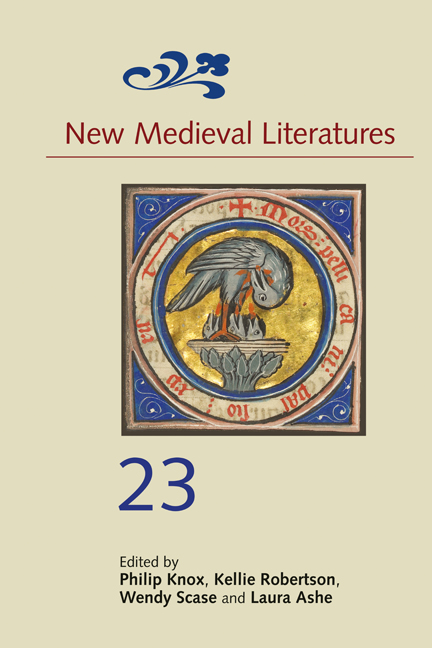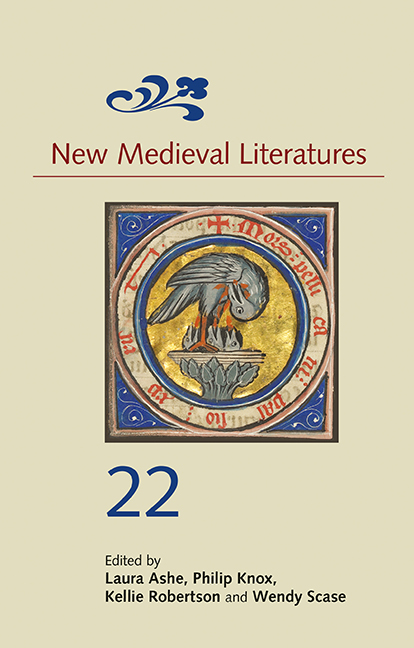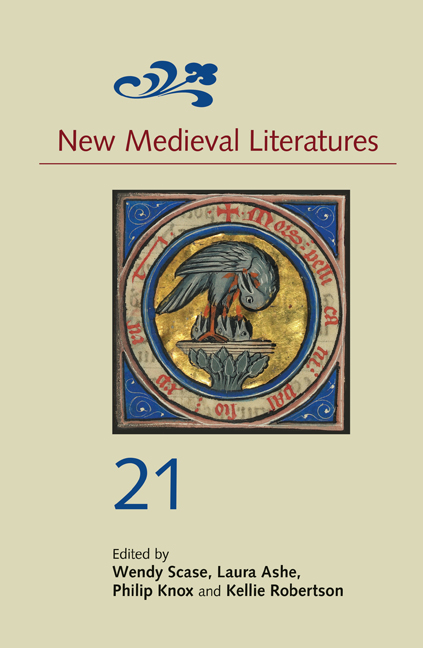44 results
Frontmatter
-
- Book:
- New Medieval Literatures
- Published by:
- Boydell & Brewer
- Published online:
- 14 May 2024
- Print publication:
- 12 March 2024, pp i-iv
-
- Chapter
- Export citation
Editors’ Note
-
- Book:
- New Medieval Literatures
- Published by:
- Boydell & Brewer
- Published online:
- 14 May 2024
- Print publication:
- 12 March 2024, pp viii-viii
-
- Chapter
- Export citation
List of Illustrations
-
- Book:
- New Medieval Literatures
- Published by:
- Boydell & Brewer
- Published online:
- 14 May 2024
- Print publication:
- 12 March 2024, pp vi-vii
-
- Chapter
- Export citation
Contents
-
- Book:
- New Medieval Literatures
- Published by:
- Boydell & Brewer
- Published online:
- 14 May 2024
- Print publication:
- 12 March 2024, pp v-v
-
- Chapter
- Export citation

New Medieval Literatures
-
- Published by:
- Boydell & Brewer
- Published online:
- 14 May 2024
- Print publication:
- 12 March 2024
List of Abbreviations
-
- Book:
- New Medieval Literatures
- Published by:
- Boydell & Brewer
- Published online:
- 14 May 2024
- Print publication:
- 12 March 2024, pp ix-x
-
- Chapter
- Export citation
Contents
-
- Book:
- New Medieval Literatures 23
- Published by:
- Boydell & Brewer
- Published online:
- 11 January 2024
- Print publication:
- 28 March 2023, pp v-v
-
- Chapter
- Export citation
Frontmatter
-
- Book:
- New Medieval Literatures 23
- Published by:
- Boydell & Brewer
- Published online:
- 11 January 2024
- Print publication:
- 28 March 2023, pp i-iv
-
- Chapter
- Export citation
List of Illustrations
-
- Book:
- New Medieval Literatures 23
- Published by:
- Boydell & Brewer
- Published online:
- 11 January 2024
- Print publication:
- 28 March 2023, pp vi-vii
-
- Chapter
- Export citation
Editors’ Note
-
- Book:
- New Medieval Literatures 23
- Published by:
- Boydell & Brewer
- Published online:
- 11 January 2024
- Print publication:
- 28 March 2023, pp viii-viii
-
- Chapter
- Export citation
List of Abbreviations
-
- Book:
- New Medieval Literatures 23
- Published by:
- Boydell & Brewer
- Published online:
- 11 January 2024
- Print publication:
- 28 March 2023, pp ix-x
-
- Chapter
- Export citation

New Medieval Literatures 23
-
- Published by:
- Boydell & Brewer
- Published online:
- 11 January 2024
- Print publication:
- 28 March 2023
Contents
-
- Book:
- New Medieval Literatures 22
- Published by:
- Boydell & Brewer
- Published online:
- 26 May 2022
- Print publication:
- 11 March 2022, pp v-vi
-
- Chapter
- Export citation
New Medieval Literatures Scholars of Colour Essay Prize
-
- Book:
- New Medieval Literatures 22
- Published by:
- Boydell & Brewer
- Published online:
- 26 May 2022
- Print publication:
- 11 March 2022, pp 301-301
-
- Chapter
- Export citation
Frontmatter
-
- Book:
- New Medieval Literatures 22
- Published by:
- Boydell & Brewer
- Published online:
- 26 May 2022
- Print publication:
- 11 March 2022, pp i-iv
-
- Chapter
- Export citation
List of Illustrations
-
- Book:
- New Medieval Literatures 22
- Published by:
- Boydell & Brewer
- Published online:
- 26 May 2022
- Print publication:
- 11 March 2022, pp vii-vii
-
- Chapter
- Export citation
List of Abbreviations
-
- Book:
- New Medieval Literatures 22
- Published by:
- Boydell & Brewer
- Published online:
- 26 May 2022
- Print publication:
- 11 March 2022, pp viii-viii
-
- Chapter
- Export citation

New Medieval Literatures 22
-
- Published by:
- Boydell & Brewer
- Published online:
- 26 May 2022
- Print publication:
- 11 March 2022
Contents
-
- Book:
- New Medieval Literatures 21
- Published by:
- Boydell & Brewer
- Published online:
- 13 April 2021
- Print publication:
- 19 March 2021, pp v-v
-
- Chapter
- Export citation

New Medieval Literatures 21
-
- Published by:
- Boydell & Brewer
- Published online:
- 13 April 2021
- Print publication:
- 19 March 2021



